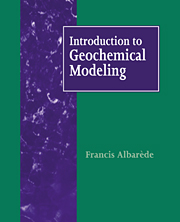Book contents
- Frontmatter
- Contents
- Foreword
- Preface
- 1 Mass balance, mixing, and fractionation
- 2 Linear algebra
- 3 Useful numerical analysis
- 4 Probability and statistics
- 5 Inverse methods
- 6 Modeling chemical equilibrium
- 7 Dynamic systems
- 8 Transport, advection, and diffusion
- 9 Trace elements in magmatic processes
- References
- Subject index
1 - Mass balance, mixing, and fractionation
Published online by Cambridge University Press: 05 February 2010
- Frontmatter
- Contents
- Foreword
- Preface
- 1 Mass balance, mixing, and fractionation
- 2 Linear algebra
- 3 Useful numerical analysis
- 4 Probability and statistics
- 5 Inverse methods
- 6 Modeling chemical equilibrium
- 7 Dynamic systems
- 8 Transport, advection, and diffusion
- 9 Trace elements in magmatic processes
- References
- Subject index
Summary
The chemical evolution of geological reservoirs, such as the upper mantle, an oceanic basin, or a magma chamber, results from the competition of two opposing kinds of processes. From a parent system with uniform (or at least smoothly changing) geochemical properties, differentiation processes generate subsystems in which these properties are usually different. Among the differentiation processes, we can mention phase changes such as crystal fractionation and partial melting, mechanical sorting, and biological activity. In the opposite direction, mixing processes tend to combine systems with distinct geochemical properties into more uniform supersystems. Mixing obviously plays a fundamental role in the formation of clastic sedimentary rocks and magmas emplaced on continental crust, while being responsible on a broad scale for the rather simple chemical properties of seawater and the isotopic characteristics of the mantle sources of basalts. This chapter deals with the basic principles of mass conservation associated with mixing and differentiation processes.
Concentrations as mixing variables
Basic concepts
The term mixing refers to a vast series of processes in which several mineral phases or chemical components are brought together in a multi-phase system (e.g., mixing of sediments) or a multi-component system (e.g., magma or seawater mixing) to form an array of hybrid samples (mixtures). The latter case is often referred to as ‘bulk mixing’ or ‘conservative mixing’ in contrast with other selective mixing processes which involve the preliminary sorting of phases or the preferential transfer of some chemical components. A phase is a system with homogeneous chemical properties that stays physically distinct in the mixture, such as quartz in a sediment, and is a term most commonly used for mechanical mixtures.
- Type
- Chapter
- Information
- Introduction to Geochemical Modeling , pp. 1 - 51Publisher: Cambridge University PressPrint publication year: 1995
- 1
- Cited by



